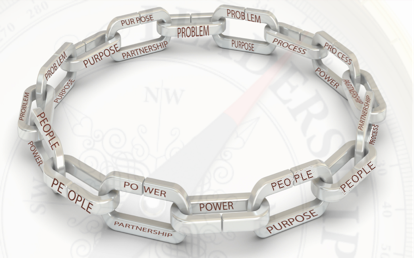
New Public Leadership and Compass 360 Leadership Values
Contextual Dynamics of Collective Leadership
The analysis of the literature and the research findings described in “The Selfless Leader” offered an insight in relation to potential dynamic interrelationships between the internal contexts of collective leadership. This highlighted the potential for identifying the various contextual dimensions that assist in identifying appropriate values and behaviours of leaders and leadership.
There are seven possible combinations shown in the table below. Each of the seven combinations is described in terms of the leadership behaviour that each contextual dimension seeks to influence and the wider leadership values that describe each such dimension in terms of its leadership outcome. From this, collective leadership values are suggested which encompass all elements of NPL framework. This provides a unique opportunity to evaluate the effectiveness of collective leadership and its outcomes.
Each of the seven contextual domains comprises three dimensions of which both the first and the third act as a link with respectively the preceding and the following domains. For example, the first domain (collective vision) comprises ‘purpose’, ‘partnership’ and ‘problem’ – with ‘problem’ acting as the link with the next domain (outcome focus), which comprises ‘problem’, ‘purpose’ and ‘process’, and so this pattern continues
[otw_shortcode_sortable_table cols=”3″ rows=”7″ col_1_title=”Leadership Contextual Dimensions” row_1_col_1_text=”1. PURPOSE/ PARTNERSHIP/ PROBLEM/ ” row_2_col_1_text=”2. PROBLEM/ PURPOSE/ PROCESS/” row_3_col_1_text=”3. PROCESS/ POWER/ PARTNERSHIP/ ” row_4_col_1_text=”4. PARTNERSHIP/ PROCESS/ PEOPLE/” row_5_col_1_text=”5. PEOPLE/ PURPOSE/ POWER/” row_6_col_1_text=”6. POWER/ PEOPLE/ PROBLEM/” row_7_col_1_text=”7. PROBLEM/ PEOPLE/ PURPOSE” col_2_title=”Leadership Behavioural Elements” row_1_col_2_text=”This very much emphasizes the collective nature of the people through partnerships, within a sense of shared purpose in tackling wicked problems” row_2_col_2_text=”Developing a framework and culture that aligns the shared purpose to public value needs through realistic goals and objectives” row_3_col_2_text=”Sharing and distributing authority, capacity and capability to target time based goals within an environment of clarity and ownership across networks at all levels.” row_4_col_2_text=”With particular reference to the sharing of information and resources this is viewed as the heart of network activity relying on trust and legitimacy in the delivery of publicly valued outcomes in a way that achieves mutual benefit.” row_5_col_2_text=”Together with adaptive approaches (below) this is considered to represent the ‘tipping point’ in turning vision and aspiration into outcomes and reality through tasking and coordination based on intelligent leadership.” row_6_col_2_text=”Encouraging ‘learning networks’ that enable innovation and improvement within a framework of governance that enhances legitimacy across those networks.” row_7_col_2_text=”Ensuring that domain knowledge and skills combine in creating the capacity and capability to improve through reflection and with demonstrable impact on problems underpinning the shared purpose.” col_3_title=”Collective Leadership Values” row_1_col_3_text=”Collective Vision” row_2_col_3_text=”Outcome Focus” row_3_col_3_text=”Multi Level Leadership” row_4_col_3_text=”Partnership Working” row_5_col_3_text=”Action Focused” row_6_col_3_text=”Systems and Structures” row_7_col_3_text=”Skills and Behaviours” title_color_class=”otw-aqua-text” title_bgcolor_class=”otw-silver” title_pattern_class=”otw-pattern-3″][/otw_shortcode_sortable_table]
The leadership narrative thus starts and ends with purpose and progresses through a focus on the ‘problem’, the ‘processes’ in dealing with those problems and the ‘power’ to deal with them (linked by the ‘partnerships’) and finally through the development of people in supporting the purpose. The problem profile as a contextual link is evident at the beginning of the cycle in linking the purpose to other internal contexts, and similarly at the end of the cycle.